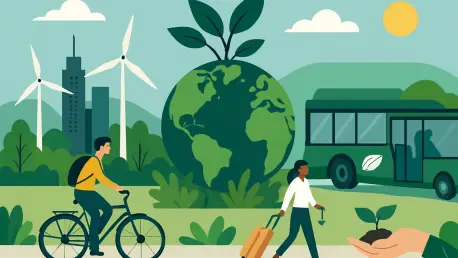Imagine a world where exploring breathtaking destinations not only fuels economic prosperity but also safeguards the planet for future generations. In 2025, the global travel and tourism industry stands at a pivotal moment, achieving a remarkable balance between driving a staggering $10.9 trillion in GDP contribution and slashing emissions intensity by 15% compared to previous benchmarks. This dual achievement signals a transformative shift, positioning the sector as both an economic powerhouse and an environmental steward. The following analysis delves into how this industry is navigating complex challenges while fostering growth, sustainability, and social impact on a global scale.
Overview of the Travel & Tourism Industry’s Dual Impact
The travel and tourism sector remains a cornerstone of the global economy, weaving together diverse segments such as transportation, hospitality, and intricate supply chains. Major players like the World Travel & Tourism Council (WTTC) spearhead initiatives to align economic ambitions with sustainability goals, often in partnership with forward-thinking entities like Oman’s Omran. These collaborations highlight a shared commitment to redefining industry standards, ensuring that growth does not come at the expense of the environment.
Beyond its operational scope, the sector’s influence is profound, contributing significantly to GDP and supporting millions of livelihoods worldwide. It serves as a vital engine for job creation, particularly in regions dependent on tourism revenue, while simultaneously championing sustainability through innovative practices. This dual role underscores its importance in shaping not just economies but also global environmental strategies.
Setting the stage for a deeper exploration, the industry’s journey reflects a delicate balancing act. Its ability to drive prosperity while addressing pressing ecological concerns positions it as a leader in sustainable development. The following sections unpack the trends, challenges, and future prospects that define this dynamic landscape.
Economic Growth and Environmental Progress
Key Trends in Emissions Reduction and Efficiency
A notable stride in the travel and tourism sector is the substantial reduction in emissions intensity, with a 15% decrease achieved through strategic efficiency gains and the adoption of low-carbon energy sources. Since 2025, the industry has seen a 16.6% surge in renewable energy integration, reflecting a concerted effort to transition away from traditional fossil fuels. These advancements signal a proactive stance toward minimizing environmental impact.
Innovations such as sustainable aviation fuels and energy-efficient infrastructure are at the forefront of this transformation, particularly in high-emission areas like transportation, which accounts for 40% of the sector’s footprint. However, challenges persist, especially in supply chains, which contribute 57.4% of emissions. Addressing these pain points requires ongoing investment and technological breakthroughs to maintain momentum.
The push for sustainability also faces hurdles in scaling these solutions across diverse markets. While progress is evident, the uneven adoption of green technologies in certain regions highlights the need for tailored approaches. Overcoming these disparities is essential to achieving uniform environmental benefits across the industry.
Economic Milestones and Growth Metrics
On the economic front, the sector has reached an impressive milestone, contributing $10.9 trillion to global GDP in 2025, marking a significant rise from prior years. This growth, coupled with a 9.3% reduction in total greenhouse gas emissions compared to historical peaks, showcases a sustainable trajectory. The numbers paint a picture of resilience and adaptability in a post-pandemic world.
Looking ahead, projections from 2025 to 2027 suggest continued expansion, bolstered by a 5.7% decline in fossil fuel reliance. This shift toward cleaner energy sources not only supports environmental goals but also enhances long-term economic stability. Such trends indicate that sustainability and profitability can indeed coexist within this vibrant sector.
These metrics reflect a broader narrative of innovation driving prosperity. As the industry capitalizes on efficiency gains, it sets a precedent for other sectors to follow, proving that environmental responsibility can align with financial success. This synergy is crucial for sustaining growth in an increasingly eco-conscious market.
Challenges in Achieving Sustainability Goals
Despite remarkable progress, the path to full sustainability is fraught with obstacles, particularly in transportation and supply chain operations. These areas remain the largest contributors to the sector’s environmental footprint, with transport alone responsible for a substantial share of emissions. Tackling this issue demands targeted strategies to curb reliance on high-carbon practices.
Investment in low-carbon infrastructure and sustainable fuels emerges as a critical need to bridge existing gaps. The urgency to scale these solutions is compounded by the complexity of global supply chains, where emissions are often harder to track and mitigate. Accelerated action is imperative to meet ambitious climate targets.
Public-private partnerships stand out as a potential catalyst for change, as emphasized by industry leaders advocating for collaborative efforts. Such alliances can unlock funding, share expertise, and drive policy reforms necessary for systemic transformation. Without these concerted efforts, the risk of falling short on sustainability commitments looms large.
Social and Fiscal Contributions of the Sector
The travel and tourism industry plays an indispensable role in fostering social equity through job creation, supporting one in ten jobs globally as of 2025. A striking increase in employment for women, reaching 126 million roles, alongside a significant share of youth holding 15.7% of direct positions, underscores the sector’s inclusivity. These figures highlight its capacity to empower diverse demographics.
Fiscally, the industry’s impact is equally compelling, generating $3.5 trillion in tax revenues in 2025, which accounts for 10% of global government income. This substantial contribution prompts calls for reinvesting these funds into sustainable infrastructure, ensuring that economic benefits translate into long-term community development. Such reinvestment is seen as a pathway to amplify the sector’s positive influence.
Balancing economic gains with social value, the sector emerges as a model of holistic progress. Its ability to create opportunities while supporting governmental budgets illustrates a multifaceted impact that extends beyond mere financial metrics. This balance is vital for maintaining public support and ensuring equitable growth across regions.
Future Outlook and Industry Innovations
Looking toward the horizon, the travel and tourism sector is poised to embrace cutting-edge solutions to persistent emissions challenges. Advanced sustainable fuels and renewable energy technologies are expected to play a pivotal role in reducing the environmental footprint, especially in high-impact areas like aviation. These innovations promise to redefine operational norms over the coming years.
Consumer preferences are also shifting, with a growing demand for eco-friendly travel options influencing industry strategies. Coupled with potential economic fluctuations globally, these dynamics could act as disruptors, necessitating agile responses from stakeholders. Adapting to these changes will be key to sustaining growth and relevance.
Strategic partnerships and evidence-based approaches remain essential for navigating this evolving landscape. Collaborations, such as those with regional leaders in sustainability, provide a blueprint for integrating economic and environmental priorities. Emphasizing such cooperative models ensures that the sector continues to lead in both innovation and responsibility.
Conclusion: A Path to Sustainable Prosperity
Reflecting on the journey thus far, the travel and tourism sector has demonstrated an extraordinary capacity to harmonize economic vigor with environmental mindfulness. The record-breaking $10.9 trillion GDP contribution in 2025, paired with a marked reduction in emissions intensity, speaks volumes about its transformative potential. Socially, the industry has uplifted millions through inclusive employment, while fiscally, it has bolstered government revenues significantly.
Moving forward, actionable steps emerge as the next frontier, with a clear need to prioritize innovation in transport and supply chain emissions through scalable sustainable fuels and renewable energy adoption. Strengthening global partnerships and securing policy support stand out as critical mechanisms to address lingering challenges. These efforts promise to cement the sector’s role as a beacon of sustainable prosperity.
Beyond immediate solutions, a broader vision takes shape, urging stakeholders to foster continuous dialogue among governments, businesses, and communities. This collaborative spirit is seen as the bedrock for ensuring that growth remains both inclusive and environmentally sound. The path ahead, though complex, holds immense promise for a future where travel enriches lives without compromising the planet.









